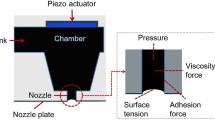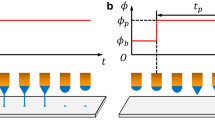Abstract
A preliminary investigation into aspects of the off-contact screen-printing process is presented. A mathematical model for the printing of a thin film of Newtonian fluid is proposed, in which the screen is modelled as a permeable membrane, and the entire region above and below the screen is flooded. By drawing upon widely used industrial circuit printing practices, the distinguished limit of greatest interest to this industry is identified. Numerical and asymptotic solutions of this distinguished limit are presented that reproduce many of the features observed in industrial screen-printing
Similar content being viewed by others
References
Kobs D.R., Voigt D.R. (1970). Parametric dependencies in thick film screening. Proc. ISHM 18:1–10
Riemer D.E. (1988). Analytical model of the screen printing process: part 1. Solid State Technol 8:107–111
Riemer D.E. (1988). Analytical model of the screen printing process: part 2. Solid State Technol 9:85–90
Riemer D.E. (1989). The theoretical fundamentals of the screen printing process. Hybrid Circuits 18:8–17
Taylor G.I. (1962). On scraping viscous fluid from a plane surface. Miszellaneen der Angewandten Mechanik 313–315.
Hunter B. (1994) A Stokes flow analysis of the screen printing process. Int. J. Microcircuits and Electronic packaging 17:21–26
Riedler J. (1983). Viscous flow in corner regions with a moving wall and leakage of fluid. Acta Mechanica 48:95–102
Chapman S.J., Fitt A.D., Please C.P. (1997). Extrusion of power-law shear thinning fluids with small exponent. Int. J. Non-linear Mech. 32:187–199
Jeong J., Kim M. (1985). Slow viscous flow due to sliding of a semi-infinite plate over a plane. J. Phys. Soc. Jpn. 54:1789–1799
Owczarek J.A., Howland F.L. (1990). A study of the off-contact screen printing process – part I:model of the printing process and some results derived from experiments. IEEE Trans. Comp. Hybrids Manuf. Technol. 13:358–367
Owczarek J.A., Howland F.L. (1990). A study of the off-contact screen printing process – part II:analysis of the model of the printing process. IEEE Trans. Comp. Hybrids Manuf. Technol. 13:368–375
Anderson J.T., Gethin D.T., Claypole T.C., Jewell E.H., Bohan M.F.J., Korochkina T.V. (2000). Hydrodynamic interactions in the screen printing process. J. Prepress and Printing Technol. 3:155–192
Glinski G.P., Bailey C., Pericleous K.A. (2001). A non-Newtonian computational fluid dynamics study of the stencil printing process. Proc. Instn. Mech. Engrs. 215:437–446
Ockendon H., Ockendon J.R. (1995). Viscous Flow. Cambridge University Press, Cambridge, 113pp.
Tio K.K., Sadhal S.S. (1994). Boundary conditions for Stokes flow near a porous membrane. Applied Scientific Research 52:1–20
Pozrikidis C. (2001). Shear flow over a particulate or fibrous plate. J. Engng. Math. 39:3–24
Pozrikidis C. (2004). Boundary conditions for a shear flow past a permeable interface modeled as an array of cylinders. Comp. Fluids 33:1–17
Pozrikidis C. (2005). Effect of membrane thickness on the slip and drift velocity in parallel shear flow. J. Fluids Struct. 20:177–187
Oron A., Davis S.H., Bankoff S.G. (1997). Long-scale evolution of thin liquid films. Rev. Modern Phys. 69: 931–980
Gradshteyn I.S., Ryzhik I.M. (1994). Table of Integrals, Series, and Products Fifth Edition. Academic Press, San Diego,1204pp.
Davis S.H., Hocking L.M.(1999). Spreading and imbibition of viscous fluid on a porous base. Phys. Fluids 11:48–57
Davis S.H., Hocking L.M.(2000). Spreading and imbibition of viscous fluid on a porous base II. Phys. Fluids 12:1646–1655
Alleborn N., Raszillier H. (2004). Spreading and sorption of a droplet on a porous substrate. Chem. Engng. Sci. 59:2071–2088
McEwan A.D., Taylor G.I. (1966). The peeling of a flexible strip attached by a viscous adhesive. J. Fluid Mech. 26:1–15
Gaver III D.P., Halpern D., Jensen O.E., Grotberg J.B. (1996). The steady motion of a semi-infinite bubble through a flexible-walled channel. J. Fluid Mech. 319:25–65
Jensen O.E., Horsburgh M.K., Halpern D., Gaver III D.P. (2002). The steady propagation of a bubble in a flexible-walled channel: asymptotic and computational models. Phys. Fluids 14:443–457
Author information
Authors and Affiliations
Corresponding author
Rights and permissions
About this article
Cite this article
White, G.S., Breward, C.J.W., Howell, P.D. et al. A model for the screen-printing of Newtonian fluids. J Eng Math 54, 49–70 (2006). https://doi.org/10.1007/s10665-005-9000-7
Received:
Accepted:
Published:
Issue Date:
DOI: https://doi.org/10.1007/s10665-005-9000-7




